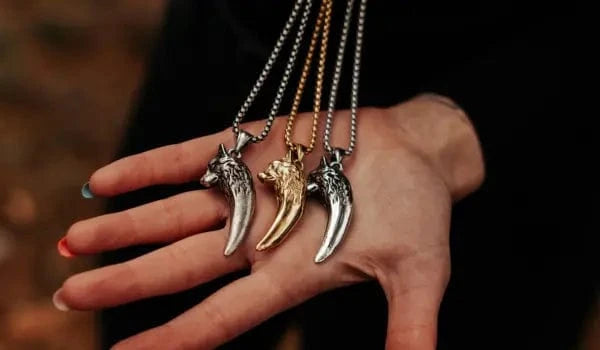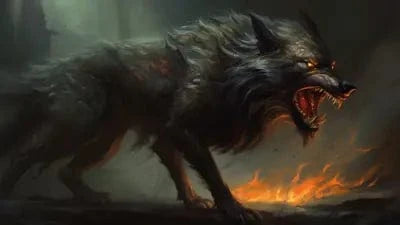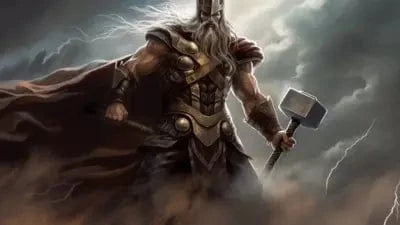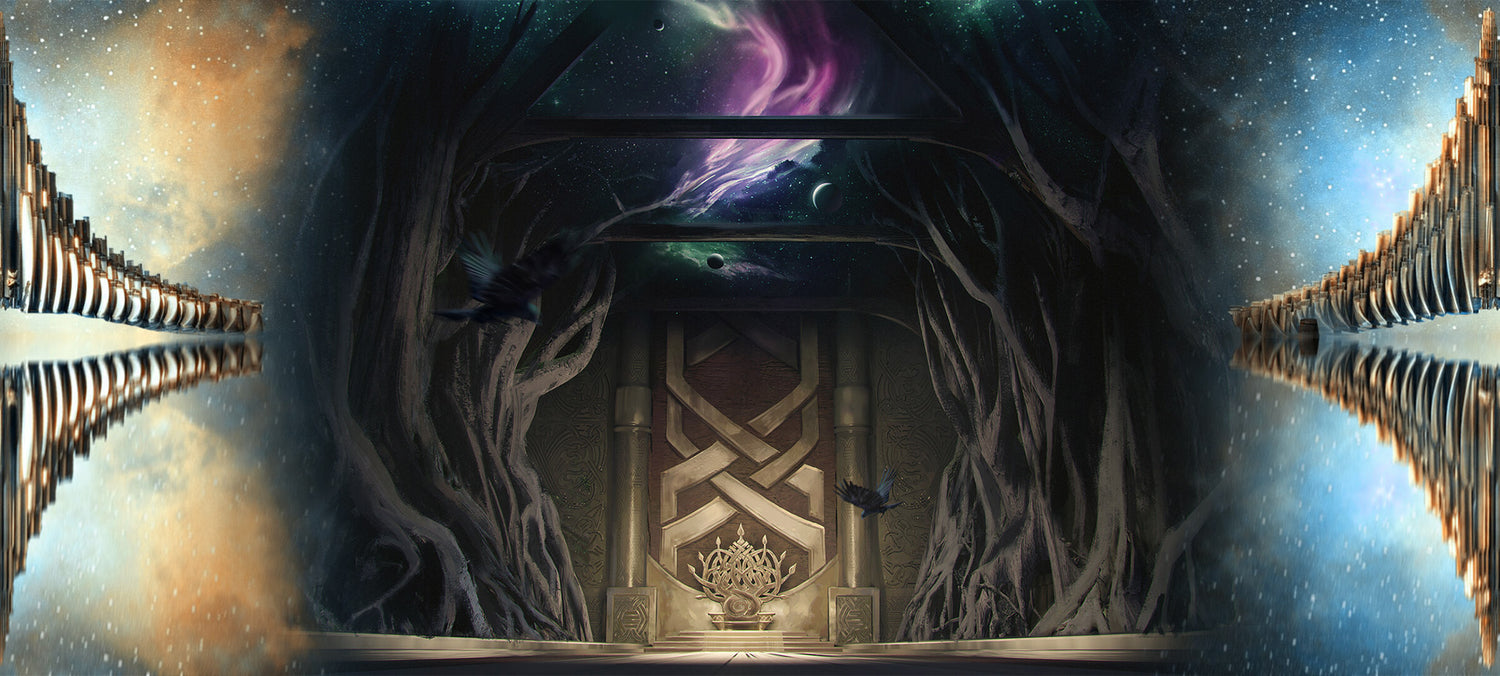Today we will tell you the story of the most beautiful and important kingdom in Norse mythology, I am of course talking about Asgard(Ásgarðr in Old Norse). It had to happen, because it's a place where the most important gods of the Nordic mythology live. Moreover, this is where the famous hall of fallen heroes is located, which is the Vikings' paradise, Valhalla.
Asgard was the home world of the Aesir gods. It was connected to Midgard by the famous Bifrost Bridge. Asgard contained 12 or more kingdoms in which the main gods lived in their extraordinary residences. The most famous of these is undoubtedly Valhalla, one of the halls belonging to Odin.
Another feature of Asgard was its impenetrable wall. This powerful barrier was so strong that no one could cross it. Since Asgard was entirely surrounded by this wall, the only entrance to the realm of the gods was through the Bifröst bridge, guarded by Heimdall.
Of course, Asgard will not escape the Ragnarok. However, it has been predicted that some Gods will survive the end of the world and eventually rebuild it, creating a new era of prosperity.
Are you ready? Let's go!

ASGARD'S PLACE IN NORDIAN MYTHOLOGY
Asgard occupied a key place in Norse mythology. She was part of a very complex system of mythological and religious beliefs shared by the Germanic and Scandinavian peoples. This belief system developed over the period from about 1000 BCE until the advent of Christianity, approximately between 900 and 1200 CE.
Throughout this period, the Norse universe was believed to have three different clans of gods: the Vanes, the Ases and the Jotuns. The difference between the Ases and Vanes tribes is relative, as both tribes made peace after a long war and eventually ruled together until the end of time.
Another symbol of the unity of the Aesir and Vanes tribes is Asgard. Although the Vanes clan had the kingdom of Vanaheim as their residence, Freyja and Njord had their residences in Asgard (Fólkvang and Nóatún). This implies that the term Asgard is not exclusive to the Aesir tribe, but is a general name used to describe the abode of the gods.
Perhaps the most significant difference between these two groups is in their areas of influence. The clan of the Ases represented war and conquest, while the tribe of the Vanes represented fertility, exploration and wealth.
On the other hand, the Jotun were a race of generally evil giants who were the sworn enemies of the Aesir and Vanes clans.
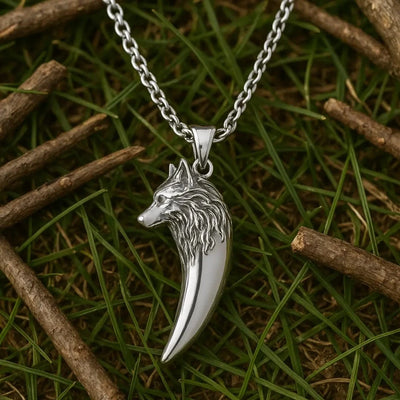
34,90€
50,00€
The origins of the word ASGARD
The word Asgard derives from the Old Norse āss, meaning God, and garðr, meaning garden or court. Essentially, Asgard means "Garden of the Gods" or "Court of the Gods".
There are many different spellings of the word Asgard, as you can see below.
- English: Ásgard, Ásgardr, Asgardr, Ásegard, Ásgarth, Ásgarthr, Asgarth, Ásgardhr, Esageard, Asgaard
- Icelandic, Faroese : Ásgarður
- Norwegian: Åsgard, Aasgaard
- Swedish and Danish : Aasgaard, Asgård
ASGARD'S PLACE IN YGGDRASIL

It's important to get back to the roots, so I suggest you read our article on Yggdrasil before continuing. Understanding its role in Norse mythology will give you a clearer picture of Asgard's place. Asgard is indeed one of the nine worlds of Yggdrasil.
The Norse universe is divided into three realms contained in the Norse tree of life, Yggdrasil. These are the kingdom of the gods, the kingdom of mortals and the kingdom of the dead. These three realms contain the nine interrelated worlds of the Norse universe.
All the beings of the Norse universe reside in these realms. The Aesir, Vanes and light elves live in the worlds located in the upper realm of Yggdrasil. The middle realm is home to worlds where giants, dwarves, dark elves and men reside. The lower realm is a place where the dead wander.
The Creation of ASGARD
The Aesir gods are believed to have built Asgard at some point in the past. According to Snorri Sturluson, it was Odin who orchestrated the creation of Asgard as we know it today.
The God of gods began by establishing rulers and giving them their first task. They were to build a huge hall with twelve seats for them, as well as a high seat for their ruler in a place called Ida-field, located in the middle of the city. The hall that the gods built was the largest in and out of the entire Nordic universe. It is known as Gladsheim.
Many other residences and meeting halls were built before the Gods realised that they were very vulnerable to attack. As fate would have it, a giant called Hrimthurs passed by. He proposed to build an impregnable wall that would surround all of Asgard with a gate that would make it invulnerable to enemy attacks.
However, the price the Gods would have to pay was very high. He asked for the sun and the moon, as well as Freya's hand in marriage. The gods accepted his offer on one condition which they thought he would not be able to fulfil. They wanted the job finished in six months (reminds one of Edifis in Mission Cleopatra), and the giant was to do it alone. The giant agreed to these terms after Loki convinced the Gods to allow him to use his horse Svadilfari (Old Norse Svaðilfari), to help him during construction.
With only a few days left, the Gods realized that the giant would eventually manage to complete his task in time. When his horse proved to be a great help, they regretted trusting the God of Cunning and Mischief. The Asgardian Gods threatened to punish Loki severely if he did not find a way to ruin the giant's construction efforts.
To avoid punishment, Loki metamorphosed into a beautiful mare and went to meet the giant's horse. The mind of Svaðilfariwas shaken, and he began to ignore the construction of the wall altogether so that he could pursue it (Svaðilfari will even have sex with Loki, who gives birth to the eight-legged horse Sleipnir. The steed will later be given to Odin as a gift).
Let's get back to our story instead of talking about Loki's frolicking as a Mare!
After trying unsuccessfully to get his horse to help him finish the wall during the last night, the giant became very angry. He realized that he would not be able to finish his masterpiece in time to win the prize. The gods neglected their oaths and called Thor. He arrived as fast as lightning.
Not only did the giant not receive his wages, but he was also denied the opportunity to return to Jötunheim. The thunder god raised Mjöllnir and struck down the giant, sending him to the realm of the dead.
To fully understand what Asgard is like, I suggest you listen to a little Nota Bene.
A DEEPER LOOK AT ASGARD
In most Norse myths, Asgard plays a central role in the adventures of the Nordic gods. This is mainly because Asgard is often depicted as the heavenly realm, where the Gods live and hold their meetings.
In addition to the many residences of the gods, Asgard is home to many other geographical features of mythic importance. The city was built on the ancient plains of Idavoll, a vast field where the gods met to discuss important matters. In addition, it was also the location of the third root of Yggdrasil, the anchor of the world.
In general, Asgard was the smallest of the nine worlds, though its territory seemed infinite. It was a realm filled with valleys, hills, and a number of flat plains that stretched to the horizon.
To the west is the ocean, which forms a border with the kingdom of Vanaheim. There is a large bay here where the ships and halls of Njörd are located. The wide and deep river known as Thund Thvitr lies to the east and serves as a border with the kingdom of Jotunheim. The river runs south along the border with Alfheim.
Once inland, the great white walls of Asgard can be seen in the distance. The only entrance is the main iron gate, known as Valgrind. As you may have already realised, Asgard is not a kingdom full of cities. No, instead, it is filled with many beautiful halls, similar to large villages. Most historians believe that there were a minimum of sixteen halls belonging to the main gods located in this kingdom. You can read about these famous halls a little later.
Finally, we must mention a vast plain called Vigrid. This is the largest of all the plains in the realm of the gods. It was foretold that this vast plain would be the battleground of the final encounter between the Gods and the forces of evil, the Ragnarök.
BIG HALL OF ASGARD
Are you ready? It's time to go into a little more detail about the great halls of Asgard:
VALHALLA
Let's start with the most famous place in all of Norse mythology, the Valhalla (Valhöll in Old Norse, meaning "hall of the dead").
Most of you know some things about Valhalla. But let us tell you a little more.
It is the home of warriors who have died in battle and are chosen by the god of gods himself. These warriors are called Einherjar. The entire hall is built with huge spearheads, while the roof is covered with many battle shields. It is believed that Valhalla had 540 gates, and behind them were accommodations for 800 warriors.
The main entrance to the hall is through massive double gates that are well guarded. There is also a secret entrance into Valhalla. It goes through the kitchen, past the famous cook Andhrimmer. The cook has a magic kettle called the Eldhrimmer. He uses it to prepare stew for all the hungry warriors in the main hall. There is a myth that Saehrimmer, the resurrecting boar, is killed every night and cooked for the feast. The boar is brought back to life the next morning, with no memory of what happened the night before.
Although this is the home of Odin, he does not spend all of his time in Valhalla. However, when he is inside, his spear Gungnir is placed over the entrance as a sign that the Father of Fathers is inside.
BILSKIRNIR
The largest hall in the Nine Worlds is Bilskirnir, the home of the god of thunder, Thor, and his family. It is even bigger than Valhalla with all the houses surrounding it. In fact, it is a small town. Bilskirnir has 640 rooms to house the fallen warriors who have sworn an oath to Thor. Thor's servants also live there. Even Loki has spent time here.
The walls of Bilskirnir are built of stone and brick. The windows in all the rooms are always open to let the air in, no matter what the weather is like outside.
There is a small hall behind Bilskirnir that belongs to Thrud, Thor's daughter. An interesting fact is that the land on which the Bilskirnir was built is called Thrudheim. Thor chose this name to show the love and pride he feels for his daughter.
GLADSHEIM
In addition to Valhalla, Odin is also the owner of another great hall within Asgard, known as Gladsheim (meaning House of Light). Gladsheim is a place where the thirteen main gods of Asgard hold their meetings.
Many animals can be seen at Gladsheim. Odin's wolves, Freki and Geri, can be seen in the meeting hall, as can Odin's ravens, Munin and Huginn. The roof of Gladsheim is reserved for Gullinkambi, the rooster who always wanders around.
There is another extraordinary building that is part of Gladsheim but is often considered a separate room because it is so huge. It is the tower of Valaskjalf. The tower is the sanctuary of Odin, and no other god is allowed to enter without Odin's permission.
Valaskjalf is built of white stone. At the top of Hlidskjalf is the magnificent throne of the god of gods. He likes to sit there and look out into the other worlds of the Norse universe.
BREIDABLIK
This great hall was given as a wedding gift to the most beloved of all the Norse gods, Baldur, and his wife, Nanna. As you may have read in our article on Baldur, after his tragic passing, his wife Nanna also passed away.
This was when the Goddess Frigg decided to seal Breidablik. She did this to preserve the hall as it was when Baldur and Nanna still lived there. This great hall is guarded at all times, and no one is allowed to enter.
LANDVIDI
This is Vidar's great hall. Vidar shares it with his mother, Grid. As well as being Odin's lover, Grid is famous for giving the God of Thunder his magical power belt and his legendary iron gloves.
As with many of the great halls of Asgard, the name Landvidi refers to the land that surrounds it. The building is surrounded by a beautiful green wood with everlasting leaves and is filled with tall green grass.
GLITNIR
Glitnir is a great hall belonging to the Norse god of justice, Forseti. Thanks to its silver roof that shines like a lighthouse, this hall can be seen from far away. Every issue that has to be settled before a judge has been discussed in the court of Glitnir.
YDALIR
Ydalir is another famous hall in Asgard belonging to the Norse god of hunting, winter and skiing, Ullr. It is quite different from the other great halls as it looks more like a simple hunting lodge in the middle of a small forest.
The High Council sometimes holds its meetings in the main halls of Ydalir.
NOATUN
Let us mention at least one hall of the Vanes gods on our list. We chose the one that is actually located outside the walls of Asgard.
It is called Noatun, and it belongs to Njörd. This hall covers the area on the west and southwest coast of Asgard. Noatun is built in the middle of a small bay, and you can see some ships still anchored in its bay.
Noatun is very different from the other halls. It is built with open windows and arched ceilings that look like the bottom of a ship. Various fishing tools can be found in this large room, and even a salty wind blows through Noatun. Almost all the furniture is built from ship parts, and many seabirds find their way inside from time to time.
In addition to the living quarters, this room contains various workshops for shipbuilding, woodcarving, barrel making, etc. Noatun is a favourite place for sailors of the nine worlds to rest after their adventures at sea. It is a paradise for all those who make their living from the sea.
VINGOLF
One of the less famous venues that few know about, but which is worth mentioning, is certainly Vingolf. As Valhalla lacked space for the Einherjar, Odin built Vingolf to make room for the overflowing fallen warriors.
However, in the course of history, this hall has become a gathering place for the goddesses of Aesir. Men are allowed to visit this great hall. Vingolf is filled with beautiful gardens and hot springs. In addition, there is a small hall built in the middle of the hot springs, which represents a special house of healing.
What happened to ASGARD DURING THE RAGNARÖK?
Like many other things in the Norse universe, it has also been predicted that Asgard will undergo complete destruction during the Ragnarök.
It will begin with the destruction of the rainbow bridge, Bifröst, by the fire giants of Muspelheim. The giants will then sack the capital.
After this terrible attack, the final battle will take place on the battlefield, where many Asgardian gods and giants will lose their lives. In the final moments, the lord of Muspelheim, Surtr, will summon such a fire that all creation will be destroyed.
However, this firestorm is not really the end point of the Norse universe. Indeed, some of the gods will manage to survive the Ragnarok. Váli and Vídarr will make it through and begin to rebuild their glorious homeland on the plains of Ida, from the ashes of Asgard.
To go a little further, discover 10 gods of Asgard with this video
FOR CONCLUSION
Asgard was a celestial world where the gods Aesir and Vanir lived. It should not be confused with the Christian notion of heaven, as Asgard was more like Mount Olympus, where Zeus and other gods of Greek mythology lived.
Driven by Odin, the God of the gods, Asgard was a place where all the important deities of Norse mythology built their homes. It is also the realm in which the famous Valhalla is located.
Another important landmark of Asgard, very popular nowadays, is the Bifrost bridge. It is the only path to the human realm, Midgard.
At the end of the day, Asgard was certainly something to behold, and any true Viking would have wanted to visit it at least once in his or her life. How about you? Would you like to visit the realm of the Norse gods? Feel free to share your ideas in the comments area below.
Thanks for reading, it's a pleasure to write for Odin's Hall, the leading brand in accessories from Norse mythology.
You can visit our Viking jewellery collections to remember the legends of Norse mythology every day.
You can also continue your reading by discovering the Valknut, its origin and meaning for example.
SKOOOL!!! Hail to Odin!
